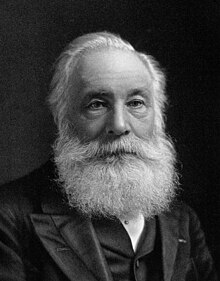William Henry Perkin
| Sir William Henry Perkin | |
|---|---|

William Perkin (1838–1907)
|
|
| Born |
12 March 1838 East End of London, United Kingdom of Great Britain and Ireland |
| Died |
14 July 1907 (aged 69) Sudbury, London |
| Nationality | British |
| Fields | Chemistry |
| Known for | Aniline dye, mauveine, Perkin triangle |
| Influences | August Wilhelm von Hofmann |
| Notable awards |
Royal Medal (1879) Davy Medal (1889) Albert Medal (1890) Perkin Medal (1906) |
Sir William Henry Perkin, FRS (12 March 1838 – 14 July 1907) was an English chemist best known for his accidental discovery of the first aniline dye: the purple mauveine. Though failing in trying to synthesise quinine for the treatment of malaria, he became successful in the field of dyes after his discovery at the age of 18.
William Perkin was born in the East End of London, the youngest of the seven children of George Perkin, a successful carpenter. His mother, Sarah, was of Scottish descent but moved to east London as a child. He was baptised in the parish church of St Paul's, Shadwell, which had been connected to such luminaries as James Cook, Jane Randolph Jefferson (mother of Thomas Jefferson) and John Wesley.
At the age of 14, Perkin attended the City of London School, where he was taught by Thomas Hall, who fostered his scientific talent and encouraged him to pursue a career in chemistry.
In 1853, at the precocious age of 15, Perkin entered the Royal College of Chemistry in London (now part of Imperial College London), where he began his studies under August Wilhelm von Hofmann. At this time, chemistry was still in a relatively primitive: although the atomic theory was accepted, the major elements had been discovered, and techniques to analyse the proportions of the elements in many compounds were in place, it was still a difficult proposition to determine the arrangement of the elements in compounds. Hofmann had published a hypothesis on how it might be possible to synthesise quinine, an expensive natural substance much in demand for the treatment of malaria. Perkin—who had by then become one of Hofmann's assistants—embarked on a series of experiments to try to achieve this end. During the Easter vacation in 1856, while Hofmann was visiting his native East End, Perkin performed some further experiments in the crude laboratory in his apartment on the top floor of his home in Cable Street in east London. It was here that he made his great accidental discovery: that aniline could be partly transformed into a crude mixture which—when extracted with alcohol—produced a substance with an intense purple colour. Perkin, who had an interest in painting and photography, immediately became enthusiastic about this result and carried out further trials with his friend Arthur Church and his brother Thomas. Since these experiments were not part of the work on quinine which had been assigned to Perkin, the trio carried them out in a hut in Perkin's garden to keep them secret from Hofmann.
...
Wikipedia
